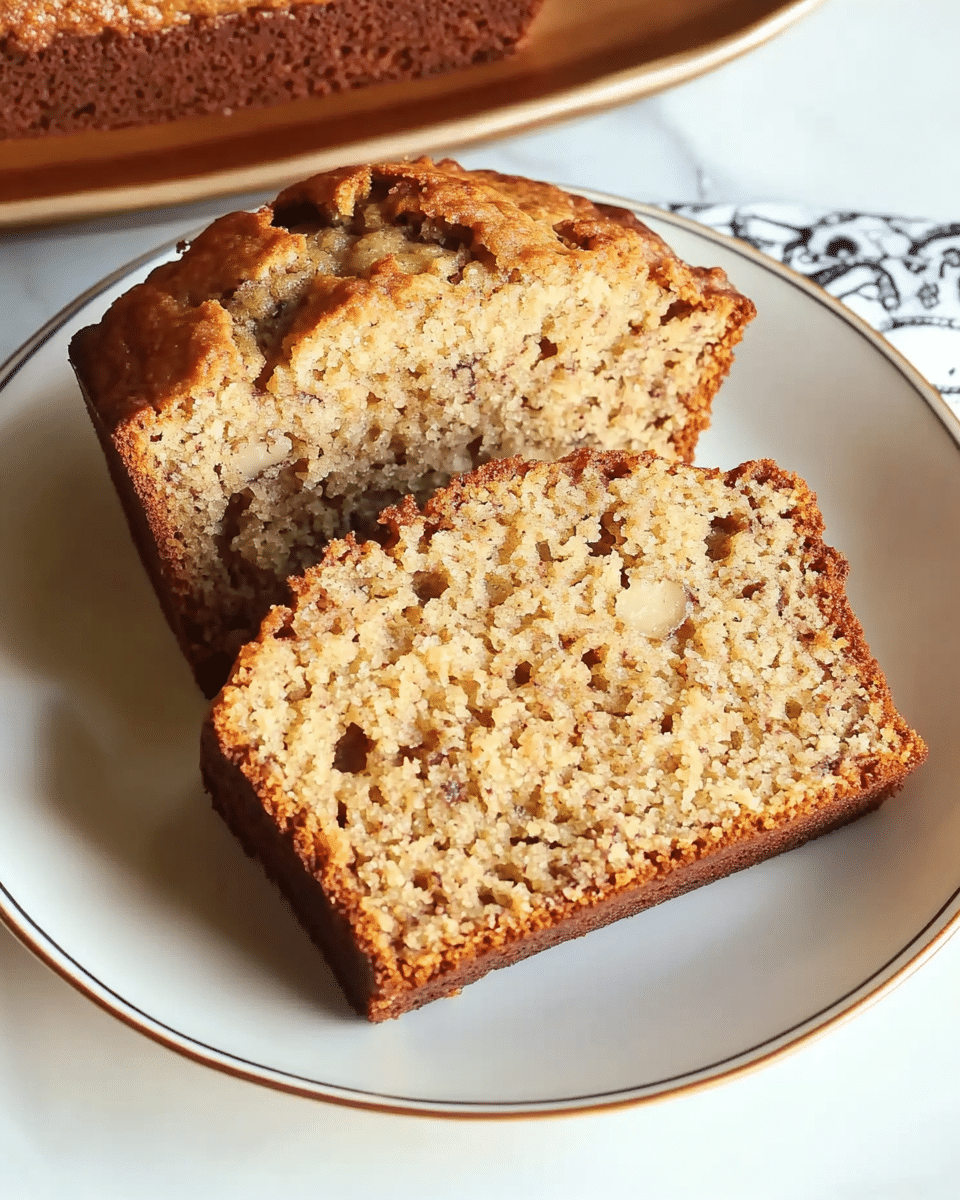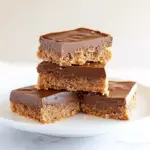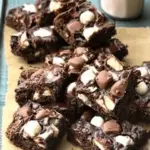Peanut Butter Banana Bread is a timeless recipe that combines simplicity, flavor, and versatility in one delightful loaf. Its rich peanut butter notes complement the natural sweetness and moisture of ripe bananas, creating a perfect harmony of taste and texture. Two perennial favorites combine to create this moist, tender peanut butter banana bread. It’s easy to make and impossible to resist!
Full Recipe
Ingredients
- All-purpose flour
- Ground cinnamon
- Baking powder
- Baking soda
- Salt
- Unsalted butter (softened)
- Light brown sugar
- Creamy peanut butter (shelf-stable variety)
- Eggs
- Vanilla extract
- Sour cream
- Mashed bananas (overripe)
- Chopped nuts (pecans, walnuts, hazelnuts, or peanuts; optional)
Directions
- Preheat your oven to 350°F (175°C) and grease a 9″ x 5″ loaf pan.
- In a mixing bowl, whisk together the flour, cinnamon, baking powder, baking soda, and salt.
- In a separate mixing bowl, use an electric mixer on medium speed to beat the softened butter, light brown sugar, and creamy peanut butter until fluffy.
- Beat in the eggs one at a time, followed by the vanilla extract.
- Reduce the mixer speed to low and mix in the dry ingredients in three portions, alternating with two portions of sour cream.
- Stir in the mashed bananas, then fold in the chopped nuts if using.
- Transfer the batter to the prepared loaf pan and smooth the top.
- Bake for 50 to 55 minutes, or until the bread is golden brown and a toothpick inserted into the center comes out clean.
- Let the bread cool in the pan on a wire rack for 10 minutes, then turn it out onto the wire rack to finish cooling.
Nutritional Facts
Note: Nutritional values are approximate and may vary based on specific ingredients used.
Per serving (based on 10 servings):
- Calories: 309
- Total Fat: 12.1g
- Saturated Fat: 4.5g
- Cholesterol: 50mg
- Sodium: 312mg
- Total Carbohydrates: 45.4g
- Dietary Fiber: 2.5g
- Total Sugars: 21g
- Protein: 7.2g
The History and Popularity of Banana Bread
Banana bread rose to prominence in the United States during the early 20th century, particularly around the Great Depression era. The invention of baking powder and baking soda as reliable leavening agents revolutionized home baking, allowing people to create moist, sweet quick breads without yeast. During the 1930s, home cooks began experimenting with overripe bananas, which were otherwise often discarded, turning them into delicious banana bread.
Over time, banana bread evolved with endless variations — adding nuts, chocolate chips, or spices to customize flavor and texture. The peanut butter version likely emerged as a natural evolution, combining two pantry staples that are beloved for their nutrition and taste. Today, peanut butter banana bread is a staple recipe for many, featured in bakeries and home kitchens alike.
Flavor Profile and Texture
What makes peanut butter banana bread truly special is its harmonious balance of flavors and its luxurious texture. The natural sugars from ripe bananas contribute moisture and sweetness, preventing the bread from drying out and giving it a tender crumb. Peanut butter adds richness, a subtle saltiness, and a creamy consistency that enhances the bread’s overall mouthfeel.
The addition of cinnamon or other spices can add warmth and depth, while optional nuts introduce a delightful crunch that contrasts with the soft bread. The sour cream or yogurt used in some recipes also boosts the moisture content and adds a slight tang, balancing the sweetness and making every slice more complex and satisfying.
Nutritional Benefits and Considerations
Peanut butter banana bread is not only delicious but also provides a decent nutritional profile compared to many desserts and quick breads. Bananas offer potassium, vitamin B6, and dietary fiber, all essential for heart health, energy metabolism, and digestive function. Peanut butter is an excellent source of plant-based protein, healthy fats, and vitamin E, which is good for skin and immune support.
While peanut butter banana bread contains sugars and fats, the fats are mostly unsaturated, which are better for heart health when consumed in moderation. Using natural or minimally processed peanut butter without added sugars or hydrogenated oils can further improve the healthfulness of the bread.
For those monitoring their calorie intake, portion control is important as the bread is energy-dense. However, this recipe can easily be adapted to include healthier ingredient swaps such as whole wheat flour, less sugar, or adding flaxseed or chia seeds for extra fiber and omega-3s.
Versatility and Serving Suggestions
One of the greatest strengths of peanut butter banana bread is its versatility. It can be enjoyed warm right out of the oven or toasted with a bit of butter or honey for breakfast. It pairs wonderfully with a hot cup of coffee or tea, making it a popular choice for morning or afternoon treats.
For a more indulgent dessert, you can serve slices with a dollop of whipped cream, a drizzle of chocolate sauce, or even spread with cream cheese frosting. Alternatively, turning it into French toast or bread pudding gives the bread a second life and impresses guests with creative flair.
It also travels well, making it a great option for packed lunches, picnics, or road trips. Because it keeps fresh for several days when wrapped tightly and stored at room temperature, it’s a convenient grab-and-go snack that doesn’t sacrifice flavor or texture.
Tips for the Best Peanut Butter Banana Bread
-
Use Overripe Bananas: The riper the bananas, the sweeter and more flavorful your bread will be. Look for bananas with lots of brown spots or that are mostly brown.
-
Choose the Right Peanut Butter: Creamy peanut butter works best for texture, but natural or homemade peanut butter can be used for a healthier twist. Avoid those with added sugars or hydrogenated oils.
-
Don’t Overmix: When combining the wet and dry ingredients, mix until just combined. Overmixing can develop gluten and make the bread tough.
-
Add Nuts or Chocolate Chips: For added texture and flavor, consider folding in chopped nuts or chocolate chips. Toasting the nuts beforehand can boost their flavor.
-
Adjust Sweetness: If your bananas are extremely ripe and sweet, you can reduce the amount of sugar. Alternatively, add a little honey or maple syrup for a different type of sweetness.
-
Baking Time and Temperature: Every oven is different, so keep an eye on your bread towards the end of baking. Use a toothpick to check for doneness.
Common Variations
While the classic peanut butter banana bread is delicious on its own, many home bakers enjoy experimenting with variations:
-
Chocolate Peanut Butter Banana Bread: Add cocoa powder to the batter or swirl in melted chocolate for a richer flavor.
-
Vegan Version: Substitute eggs with flax or chia egg replacers and use plant-based yogurt or sour cream alternatives.
-
Gluten-Free: Use gluten-free flour blends to accommodate dietary restrictions while maintaining a tender crumb.
-
Added Seeds or Grains: Boost nutrition by mixing in flaxseeds, chia seeds, or oats.
Each variation can provide a unique twist, keeping this recipe fresh and exciting while catering to different dietary needs and preferences.
Why Peanut Butter Banana Bread is a Crowd-Pleaser
The combination of peanut butter and banana offers familiarity and comfort, but with enough unique flair to make it feel special. It appeals to people of all ages, from kids who love the sweet and nutty taste to adults who appreciate a wholesome treat that feels indulgent yet not overly sweet.
This bread also has the advantage of using ingredients that are common pantry staples, making it an easy go-to recipe when you want something quick and satisfying. Whether for a family breakfast, a bake sale, or a casual gathering, peanut butter banana bread is always a hit.
Storing and Freezing
To maintain freshness, peanut butter banana bread should be stored tightly wrapped in plastic wrap or kept in an airtight container at room temperature for up to 3 days. For longer storage, it freezes well: slice the bread first, then wrap each slice individually before placing in a freezer-safe bag. This way, you can thaw single portions as needed without sacrificing taste or texture.
When ready to eat, thaw slices at room temperature or gently warm in a toaster or oven. This makes it an ideal make-ahead option for busy mornings or unexpected guests.
Conclusion
Peanut Butter Banana Bread is a timeless recipe that combines simplicity, flavor, and versatility in one delightful loaf. Its rich peanut butter notes complement the natural sweetness and moisture of ripe bananas, creating a perfect harmony of taste and texture. Beyond just being a tasty treat, this bread offers nutritional benefits from its wholesome ingredients and can easily be tailored to fit various dietary needs.






